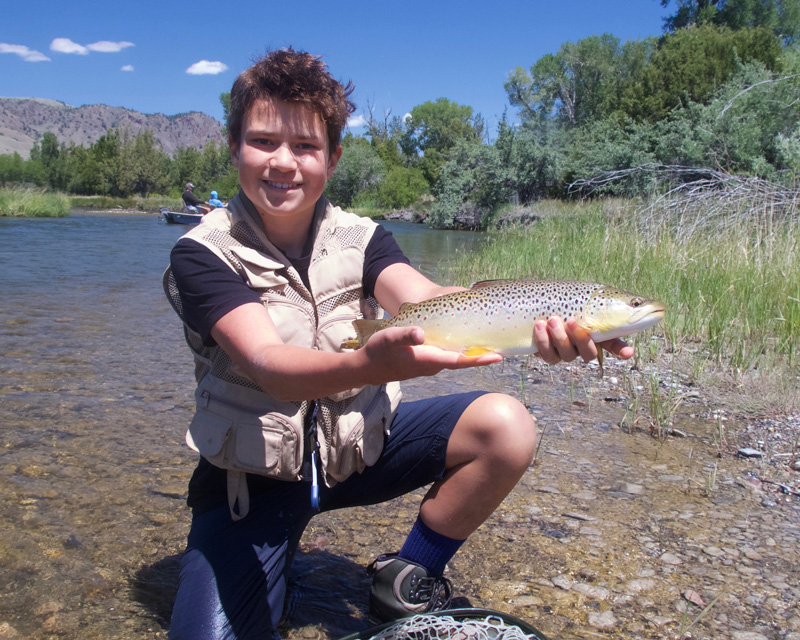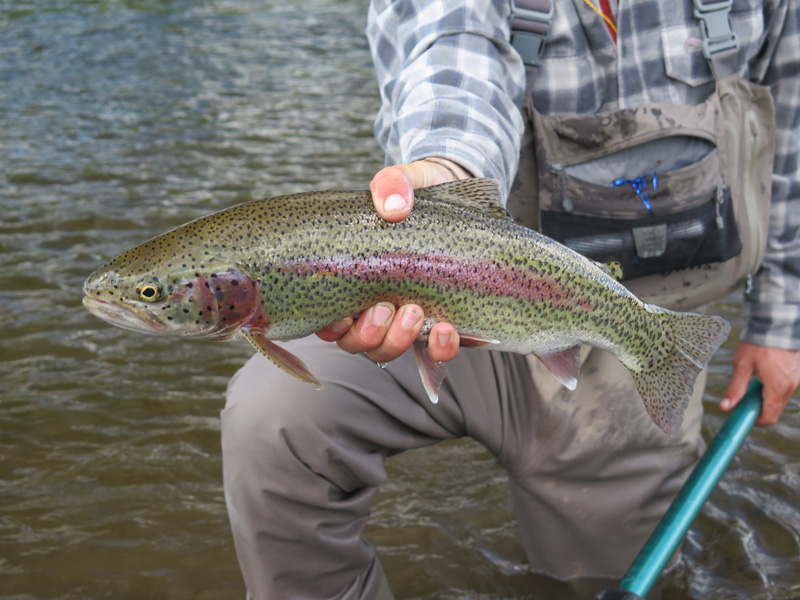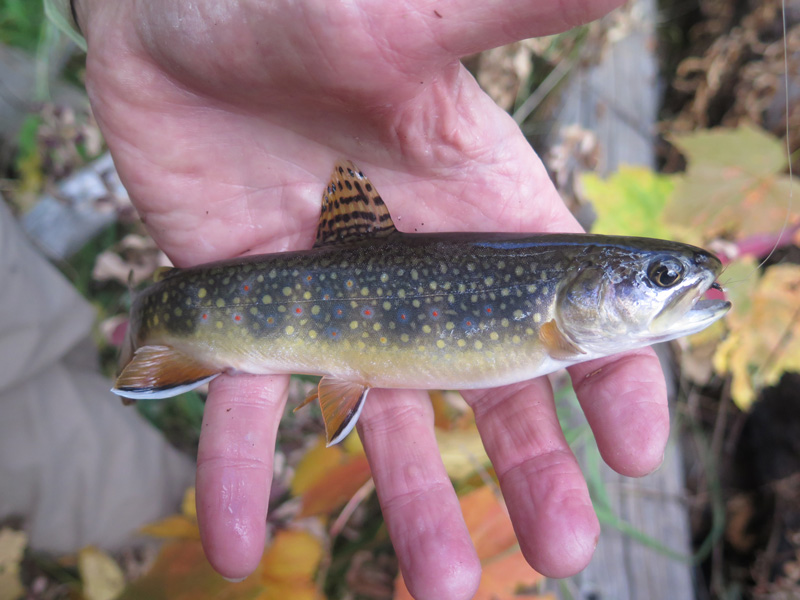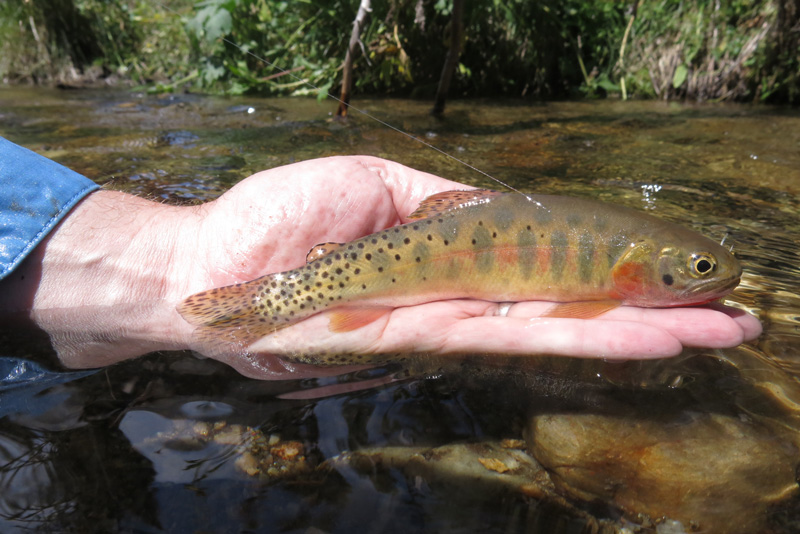Anyone who’s known me for more than a few minutes has learned that I am somewhat of a trout geek. Since I first became aware of their existence as a very young child—my brother and I caught a brown trout in our grandparents’ acequia in Talpa—trout have been my world. I understand that this is not true for everybody; yet, for a variety of reasons, it may be important for folks fishing the Questa area to be able to differentiate between trout species. Several streams in Questa harbor both native trout (Rio Grande cutthroats) and introduced species described above. Different regulations apply to each, particularly on Cabresto and Columbine Creeks, where cutthroats must be released. The other species are subject to unlimited harvest.
German Brown Trout

The brown trout is probably the most common trout species in the Questa area. Many are unaware that the fish is not native to northern New Mexico or even the continent of North America. Browns were imported from Scotland and Germany in the late 1800s and distributed widely across the nation. Browns have the reputation of being smarter than other trouts (they are) and have come to dominate so many watersheds. Other reasons: they are inclined to eat other fish; their eyes are better adapted to night feeding, and; browns reproduce (spawn) in the fall, when stream conditions are stable and newborns are therefore more likely to survive.
Rainbow Trout

Native to watersheds around the Pacific Rim (California, British Columbia, Alaska, Russia) rainbow trout were probably introduced to New Mexico around the time of statehood. Indeed, the rainbow—particularly the McCloud River variety from northern California—ushered in the age of hatcheries and mass-produced sportfishing, which spanned the globe to places like Chile, Argentina, New Zealand, and other places where trout and salmon didn’t evolve naturally. We find the manufactured version of rainbows at Eagle Rock Lake, Eagle Nest, and the Red River, and the wild version is common in the Rio Grande gorge. The Rio’s rainbows often bear the trademark scarlet throat marks of the native cutthroat, a reminder that rainbows are evolutionarily close enough to cutts (along with genetic similarity, they both spawn in the springtime) that they can still successfully breed with them. In fact, part of the reason cutthroats are threatened everywhere is that interbreeding with rainbows has polluted their gene pool.
Eastern Brook Trout

In my experience, the fall-spawning brook trout is easier to catch and much tastier than other trout species. Like brown trout, they are famous for taking over fisheries such as the Cabresto Watershed, Middle Fork Lake, and the entire Cruces Basin west of the gorge. Ironically, as prolific as they are in the west, brook trout are rare in their native east coast and upper midwest range, where development and industrialization polluted and otherwise destroyed their habitat when our nation was still young. Brookies do well in the west due to their need for very cold water—a rarity out east, but quite common here. Another brookie fact: the brook trout is not a trout at all but what’s technically known as a char. Char are distinguished by their light spots on a darker body color. “True trout” (rainbow, brown, cutthroat) can be recognized by black spots on a lighter background. Other char species include lake trout, bull trout, Arctic char, and the spectacular Dolly Varden trout.
Rio Grande Cutthroat Trout

Cutthroat trout were once the only trout species occupying the inner mountain west, from the Pacific northwest down to the New Mexico/Texas border area. As recently as the 1970s, all cutthroats were considered to be one species, but studies have since determined that different varieties evolved as the formation of distinct mountain ranges created the geographical isolation required for speciation. It has been speculated that Lake Alamosa, an enormous extinct water body spanning the entire San Luis Valley, contained one species of cutthroat trout. Several millions of years ago, the lake overflowed—a monstrous flooding event that created the Rio Grande gorge and united the Rio with the Red River. That turmoil may also have separated the lake’s trout into two hydrologically separate geographies. This separation may have resulted in the parallel evolution of the greenback cutthroat trout, native to watersheds draining Colorado’s Front Range, and Questa’s own Rio Grande cutthroat species. Unfortunately, before such stories were fully understood, all cutthroats were considered the same, and the stocking of out-basin cutthroats in native habitat was widely practiced. In New Mexico, for example, stocking of Yellowstone and Snake River cutthroats from Wyoming has resulted in the contamination of Rio Grande populations.



